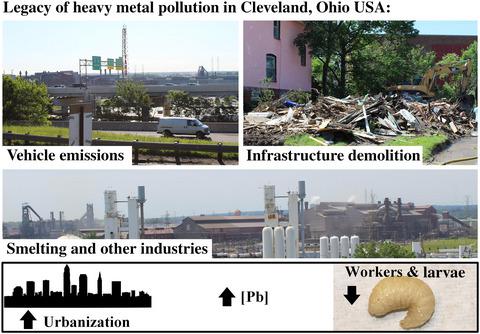当前位置:
X-MOL 学术
›
J. Appl. Ecol.
›
论文详情
Our official English website, www.x-mol.net, welcomes your
feedback! (Note: you will need to create a separate account there.)
Urban heavy metal contamination limits bumblebee colony growth
Journal of Applied Ecology ( IF 5.0 ) Pub Date : 2020-06-11 , DOI: 10.1111/1365-2664.13651 Frances S. Sivakoff 1 , Scott P. Prajzner 1 , Mary M. Gardiner 1
中文翻译:

城市重金属污染限制了大黄蜂菌落的生长
更新日期:2020-06-11
Journal of Applied Ecology ( IF 5.0 ) Pub Date : 2020-06-11 , DOI: 10.1111/1365-2664.13651 Frances S. Sivakoff 1 , Scott P. Prajzner 1 , Mary M. Gardiner 1
Affiliation

|
- Post‐industrial shrinking cities contain abundant vacant land and are increasingly recognized for their pollinator conservation potential. At the same time, the industrial legacies of these urban ecosystems have resulted in elevated levels of heavy metals in surface soils, which could negatively affect bee populations.
- We investigated whether foraging within heavy metal contaminated landscapes represents a fitness cost for the common Eastern bumblebee Bombus impatiens, by placing colonies in residential backyards along an urban to rural gradient extending south and east from the city of Cleveland, Ohio, USA. Bees foraged in the landscape for 3 weeks, after which time we counted the total number of workers and larvae present in the colony and analysed castes for the presence of heavy metals. We then assessed the relationship between landscape composition, heavy metal loads and caste abundance.
- Colonies located in urban landscapes were more likely to be exposed to lead (Pb). Elevated concentrations of Pb within workers were negatively correlated with both the number of workers and the number of larvae present.
- Synthesis and applications. Our findings raise concern that lead (Pb) contamination could represent a significant challenge to bee conservation in cities. To elucidate risks posed by this pollutant, we highlight a need to quantify lethal and sub‐lethal effects of Pb exposure using laboratory and field‐based studies. Further, identifying routes of exposure and landscape factors that influence exposure risk is necessary to implement mitigation strategies as part of urban conservation initiatives.
中文翻译:

城市重金属污染限制了大黄蜂菌落的生长
- 工业化后的萎缩城市拥有大量的闲置土地,并且因其传粉媒介保护潜力而日益受到认可。同时,这些城市生态系统的工业遗产导致表层土壤中的重金属含量升高,这可能对蜜蜂种群产生负面影响。
- 我们调查了在重金属污染的景观中觅食是否代表常见的东部大黄蜂Bombus impatiens的适应成本,方法是将菌落沿着从美国俄亥俄州克利夫兰市向南和向东延伸的城市到乡村的梯度放置在住宅后院中。蜜蜂在景观中觅食了3周,之后我们对种群中存在的工人和幼虫总数进行了计数,并分析了种姓中是否存在重金属。然后,我们评估了景观组成,重金属负载和种姓丰度之间的关系。
- 位于城市景观中的殖民地更有可能暴露于铅(Pb)。工人中铅的浓度升高与工人数量和幼虫数量呈负相关。
- 综合与应用。我们的发现引起人们的关注,铅(Pb)污染可能对城市养蜂业构成重大挑战。为了阐明这种污染物带来的风险,我们强调需要使用实验室和现场研究来量化铅暴露的致死和亚致死作用。此外,要确定缓解策略作为城市保护计划的一部分,必须确定影响暴露风险的暴露途径和景观因素。











































 京公网安备 11010802027423号
京公网安备 11010802027423号